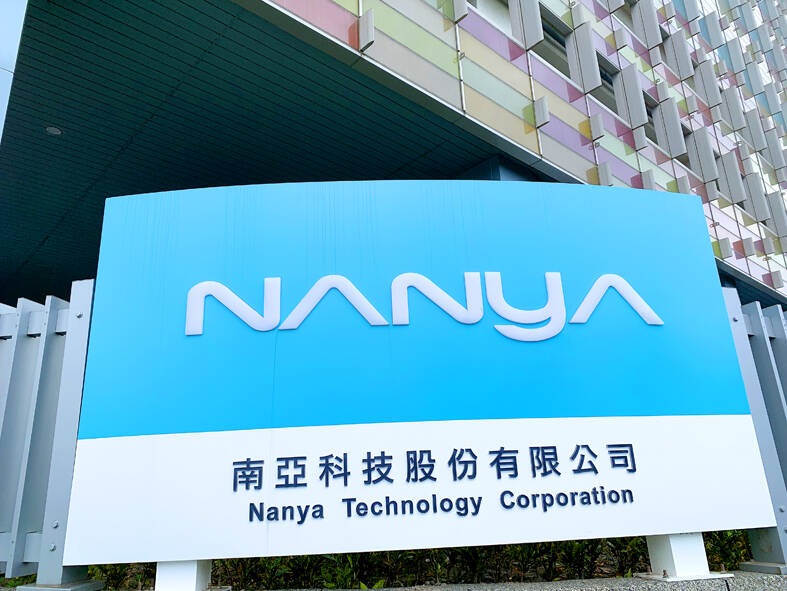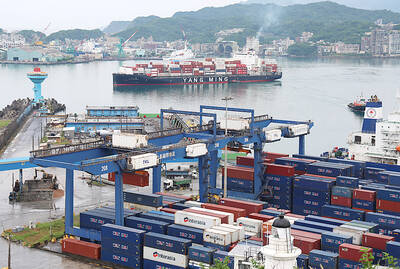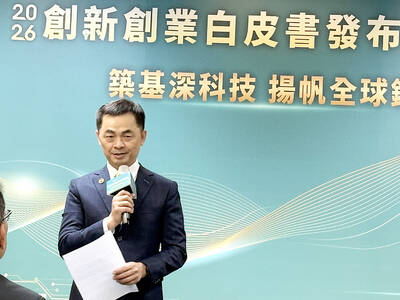Nanya Technology Corp (南亞科技), the world’s fourth-largest DRAM chipmaker, yesterday posted its smallest quarterly loss since the second quarter of last year as gross margin returned to positive territory for the first time in six quarters, driven by improvements in chip prices.
Losses narrowed to NT$813 million (US$24.95 million) during the quarter ended on June 30, compared with losses of NT$1.21 billion in the previous quarter. On an annual basis, losses widened from NT$771 billion.
Gross margin improved to 2.9 percent, compared with minus-2.9 percent in the first quarter and minus-11.2 percent in the second quarter last year.

Photo: Grace Hung, Taipei Times
Nanya Technology said it would have nearly broke even last quarter, if not for the effects of a massive earthquake in April that led to the company incurring about NT$657 million in damage.
Nanya president Lee Pei-ing (李培瑛) said the company might be able to post a profit this quarter, thanks to improving DDR4 inventory and better average selling prices, following a sequential increase of 12 to 13 percent last quarter.
Earlier this week, TrendForce Corp (集邦科技) predicted that DRAM prices would increase 8 to 13 percent this quarter from a quarter earlier.
The company’s shipments are expected to return to growth this quarter after dropping 5 percent sequentially last quarter, Lee said.
Shipments for the whole of this year are expected to grow 20 percent, given a lower comparison base last year, he said.
As the world’s three major memorychip makers race to produce high-bandwidth memory (HBM) chips and DDR5 modules used in artificial intelligence servers or high-end servers, the companies would produce fewer DDR4 chips, which would benefit Nanya Technology, he said.
However, economic slowdowns in China and Europe, along with geopolitical tensions, would continue to affect the use of DRAM chips used in PCs, smartphones and consumer electronics, Lee said.
China, alone, purchases about 40 percent of mobile DRAM, he said.
Nanya Technology has no plans to produce HBM chips in the short term, as the company’s strategy is to tap the DDR5 market first, he said.
DDR5 chips are also used in high-end cloud-computing devices and PCs, the company said.
The company plans to roll out its first DDR5 modules with 16-gigabit capacity in the second half of this year, with estimated sales contribution reaching about 10 percent of its monthly revenue, Lee said.
Nanya Technology has resumed full production on its chip lines and does not expect a strike by Samsung Electronics Co workers to affect supply and demand in the market, he said.

CHIP RACE: Three years of overbroad export controls drove foreign competitors to pursue their own AI chips, and ‘cost US taxpayers billions of dollars,’ Nvidia said China has figured out the US strategy for allowing it to buy Nvidia Corp’s H200s and is rejecting the artificial intelligence (AI) chip in favor of domestically developed semiconductors, White House AI adviser David Sacks said, citing news reports. US President Donald Trump on Monday said that he would allow shipments of Nvidia’s H200 chips to China, part of an administration effort backed by Sacks to challenge Chinese tech champions such as Huawei Technologies Co (華為) by bringing US competition to their home market. On Friday, Sacks signaled that he was uncertain about whether that approach would work. “They’re rejecting our chips,” Sacks

Taiwan’s exports soared 56 percent year-on-year to an all-time high of US$64.05 billion last month, propelled by surging global demand for artificial intelligence (AI), high-performance computing and cloud service infrastructure, the Ministry of Finance said yesterday. Department of Statistics Director-General Beatrice Tsai (蔡美娜) called the figure an unexpected upside surprise, citing a wave of technology orders from overseas customers alongside the usual year-end shopping season for technology products. Growth is likely to remain strong this month, she said, projecting a 40 percent to 45 percent expansion on an annual basis. The outperformance could prompt the Directorate-General of Budget, Accounting and

NATIONAL SECURITY: Intel’s testing of ACM tools despite US government control ‘highlights egregious gaps in US technology protection policies,’ a former official said Chipmaker Intel Corp has tested chipmaking tools this year from a toolmaker with deep roots in China and two overseas units that were targeted by US sanctions, according to two sources with direct knowledge of the matter. Intel, which fended off calls for its CEO’s resignation from US President Donald Trump in August over his alleged ties to China, got the tools from ACM Research Inc, a Fremont, California-based producer of chipmaking equipment. Two of ACM’s units, based in Shanghai and South Korea, were among a number of firms barred last year from receiving US technology over claims they have

BARRIERS: Gudeng’s chairman said it was unlikely that the US could replicate Taiwan’s science parks in Arizona, given its strict immigration policies and cultural differences Gudeng Precision Industrial Co (家登), which supplies wafer pods to the world’s major semiconductor firms, yesterday said it is in no rush to set up production in the US due to high costs. The company supplies its customers through a warehouse in Arizona jointly operated by TSS Holdings Ltd (德鑫控股), a joint holding of Gudeng and 17 Taiwanese firms in the semiconductor supply chain, including specialty plastic compounds producer Nytex Composites Co (耐特) and automated material handling system supplier Symtek Automation Asia Co (迅得). While the company has long been exploring the feasibility of setting up production in the US to address